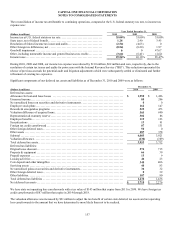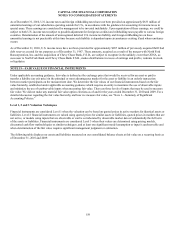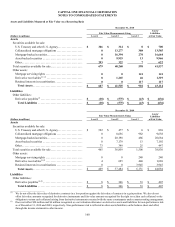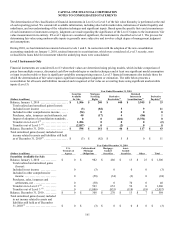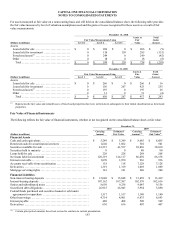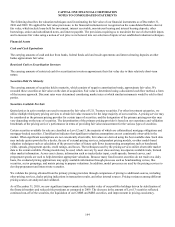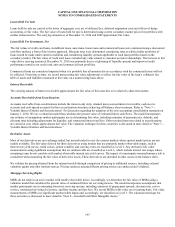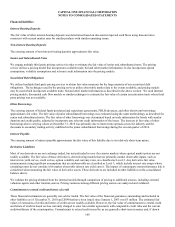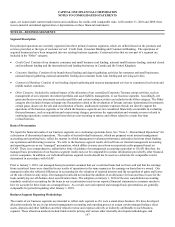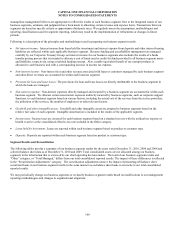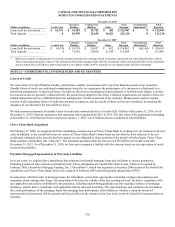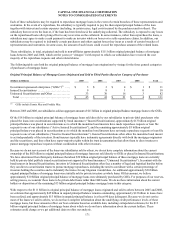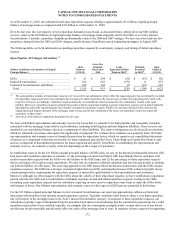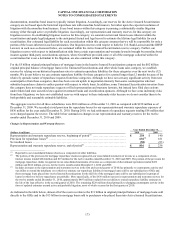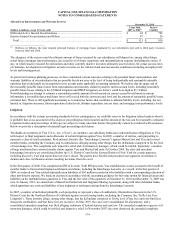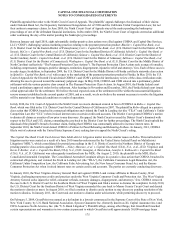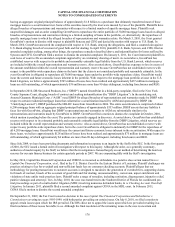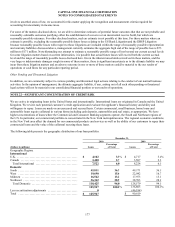Capital One 2010 Annual Report Download - page 187
Download and view the complete annual report
Please find page 187 of the 2010 Capital One annual report below. You can navigate through the pages in the report by either clicking on the pages listed below, or by using the keyword search tool below to find specific information within the annual report.
CAPITAL ONE FINANCIAL CORPORATION
NOTES TO CONSOLIDATED STATEMENTS
167
upon, are issued under current market terms and conditions for credits with comparable risks. At December 31, 2010 and 2009, there
was no material unrealized appreciation or depreciation on these financial instruments.
NOTE 20—BUSINESS SEGMENTS
Segment Description
Our principal operations are currently organized into three primary business segments, which are defined based on the products and
services provided, or the type of customer served: Credit Card, Consumer Banking and Commercial Banking. The operations of
acquired businesses have been integrated into our existing business segments. Certain activities that are not part of a segment are
included in the “Other” category.
• Credit Card: Consists of our domestic consumer and small business card lending, national small business lending, national closed
end installment lending and the international card lending businesses in Canada and the United Kingdom.
• Consumer Banking: Consists of our branch-based lending and deposit gathering activities for consumer and small businesses,
national deposit gathering, national automobile lending and consumer home loan lending and servicing activities.
• Commercial Banking: Consists of our lending, deposit gathering and treasury management services to commercial real estate and
middle market customers.
• Other Category: Includes the residual impact of the allocation of our centralized Corporate Treasury group activities, such as
management of our corporate investment portfolio and asset/liability management, to our business segments. Accordingly, net
gains and losses on our investment securities portfolio and certain trading activities are included in the Other category. The Other
category also includes foreign exchange-rate fluctuations related to the revaluation of foreign currency-denominated investments;
certain gains (losses) on the sale and securitization of loans; unallocated corporate expenses that do not directly support the
operations of the business segments or for which the business segments are not considered financially accountable in evaluating
their performance, such as acquisition and restructuring charges; provisions for representation and warranty reserves related to
continuing operations; certain material items that are non-recurring in nature; and offsets related to certain line-item
reclassifications.
Basis of Presentation
We report the financial results of our business segments on a continuing operations basis. See “Note 3—Discontinued Operations” for
a discussion of discontinued operations. The results of our individual businesses, which are prepared on an internal management
accounting and reporting basis, reflect the manner in which management evaluates performance and makes decisions about funding
our operations and allocating resources. We refer to the business segment results derived from our internal management accounting
and reporting process as our “managed” presentation, which differs in some cases from our reported results prepared based on
GAAP. There is no comprehensive, authoritative body of guidance for management accounting equivalent to GAAP; therefore, the
managed basis presentation of our business segment results may not be comparable to similar information provided by other financial
service companies. In addition, our individual business segment results should not be used as a substitute for comparable results
determined in accordance with GAAP.
Prior to January 1, 2010, our managed-basis presentation assumed that our securitized loans had not been sold and that the earnings
from securitized loans were classified in our results of operations in the same manner as the earnings on loans that we owned. Our
managed results also reflected differences in accounting for the valuation of retained interests and the recognition of gains and losses
on the sale of interest-only strips. Our managed results did not include the addition of an allowance for loan and lease losses for the
loans underlying our off-balance sheet securitization trusts. The adoption on January 1, 2010 of the new consolidation accounting
standards resulted in accounting for the loans in our securitization trusts in our reported financial statements in a manner similar to
how we account for these loans on a managed basis. As a result, our total reported and managed basis presentations are generally
comparable for periods beginning after January 1, 2010.
Business Segment Reporting Methodology
The results of our business segments are intended to reflect each segment as if it were a stand-alone business. We have developed
allocation methods for use in our internal management accounting and reporting process to assign certain managed balance sheet
assets, deposits and other liabilities and their related revenue and expenses directly or indirectly attributable to each business
segment. These allocation methods include funds transfer pricing and various other internally-developed methodologies and


